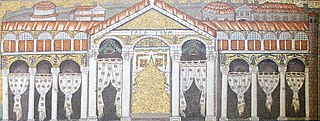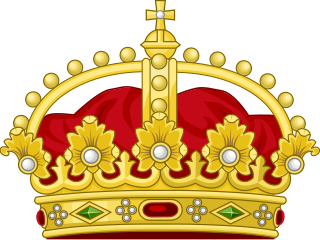
The Germanic peoples are an Indo-European ethnolinguistic group of Northern European origin identified by their use of the Germanic languages. Their history stretches from the 2nd millennium BCE up to the present day.

The Ostrogoths were the eastern branch of the older Goths. The Ostrogoths traced their origins to the Greutungi – a branch of the Goths who had migrated southward from the Baltic Sea and established a kingdom north of the Black Sea, during the 3rd and 4th centuries. They built an empire stretching from the Black Sea to the Baltic. The Ostrogoths were probably literate in the 3rd century, and their trade with the Romans was highly developed. Their Danubian kingdom reached its zenith under King Ermanaric, who is said to have committed suicide at an old age when the Huns attacked his people and subjugated them in about 370.
Bard the Bowman is a character in J. R. R. Tolkien's The Hobbit. A Man of Laketown and a descendant of the ancient Lords of Dale, Bard manages to kill Smaug, the dragon, after which he becomes king of Dale. Tolkien created the character specifically to kill Smaug, since none of the other protagonists of the story were able to fulfill this role. Bard the Bowman could have been inspired by Wiglaf from Anglo-Saxon poem Beowulf.
Thorin II Oakenshield, son of Thráin, son of Thrór, King under the Mountain is a fictional character in J. R. R. Tolkien's 1937 novel The Hobbit. Thorin is the leader of the Company of Dwarves who aim to reclaim the Lonely Mountain from Smaug the dragon. He is the son of Thráin II, grandson of Thrór, and becomes King of Durin's Folk during their exile from Erebor. Thorin's background is further elaborated in Appendix A of Tolkien's 1955 novel The Return of the King.

In J. R. R. Tolkien's Middle-earth legendarium, the Lonely Mountain is a mountain in the north of Wilderland. It is the source of the Celduin River, and the location of the Kingdom under the Mountain. The town of Dale lies in a vale on its southern slopes.

In the fantasy of J. R. R. Tolkien, the Dwarves are a race inhabiting Middle-earth, the central continent of Earth in an imagined mythological past. They are based on the dwarfs of Germanic myths: small humanoids that dwell in mountains, and are associated with mining, metallurgy, blacksmithing and jewellery.
Thranduil is a fictional character in J. R. R. Tolkien's Middle-earth legendarium. He is a supporting character in The Hobbit, where he is referred to as the Elvenking, and he figures briefly in The Lord of the Rings, The Silmarillion, and Unfinished Tales. Tolkien describes Thranduil as having a crown made of red leaves and berries in the autumn, and wearing a similar crown of flowers in the spring. The Hobbit describes the woodland king "with a crown of leaves upon his golden hair". Like most of the Sindar, he would have been beardless, tall, and grey-eyed. The name "Thranduil" means "vigorous spring" in Sindarin.
The Iron Hills are a fictional range of mountains in J. R. R. Tolkien's Middle-earth writings. They are remnants of the Iron Mountains of the First Age and are located east of the Lonely Mountain in the northeastern part of Wilderland and the northwest of Rhûn. The Iron Hills are a realm of Dwarves. In Tolkien's novel The Hobbit, an army of Dwarves from the Iron Hills under Dáin II Ironfoot comes to the aid of Thorin Oakenshield in the Battle of Five Armies.
Thráin II is a fictional character in J. R. R. Tolkien's legendarium. He is first mentioned in The Hobbit and more of his history is given in Unfinished Tales.
Dáin II Ironfoot is a Dwarf and king of Erebor in J. R. R. Tolkien's high fantasy legendarium concerning Middle-earth. He appears briefly in The Hobbit and his story is elaborated in Appendix A of The Lord of the Rings.
Oin, Óin or OIN may refer to:
"The Quest of Erebor" is a work of fantasy fiction by J. R. R. Tolkien, posthumously published by his son Christopher Tolkien in Unfinished Tales (1980). This work explains how and why Gandalf arranged for the retaking of the Lonely Mountain, an adventure recounted from the perspective of Bilbo Baggins many years before in Tolkien's The Hobbit.
The Battle of Dale is a fictional battle in J. R. R. Tolkien's The Lord of the Rings during the War of the Ring. An earlier battle in the same location which preceded a re-establishment of the Dwarf-kingdom was called the Battle of Five Armies.
Balin is a fictional character in J. R. R. Tolkien's legendarium. He is an important supporting character in The Hobbit, and is mentioned in The Fellowship of the Ring.
Gandalf (Gandálfr) is a Dvergr in Norse mythology, appearing in the so-called 'Tally of the Dwarves' within the poem Völuspá from the Poetic Edda, as well as in the Prose Edda. The name derives from the Old Norse words gandr and álfr (elf), thus a protective spirit who wields a magical wand.
Dáinn ("Dead") or Dain is a character in Norse mythology. Mostly the tales relate to him being a dwarf and in others as king of elves. However, in other stories the dwarf god is referred to as Dvalin.
Germanic given names are traditionally dithematic; that is, they are formed from two elements, by joining a prefix and a suffix. For example, King Æþelred's name was derived from æþele, for "noble", and ræd, for "counsel".
Many of the fictional characters in J.R.R. Tolkien's legendarium are Dwarves, a short stocky race inhabiting the world of Arda. Dwarves lived in the continent Middle-earth, mostly under its mountains.

King, or king regnant is the title given to a male monarch in a variety of contexts. The female equivalent is queen regnant, while the title of queen on its own usually refers to the consort of a king.





